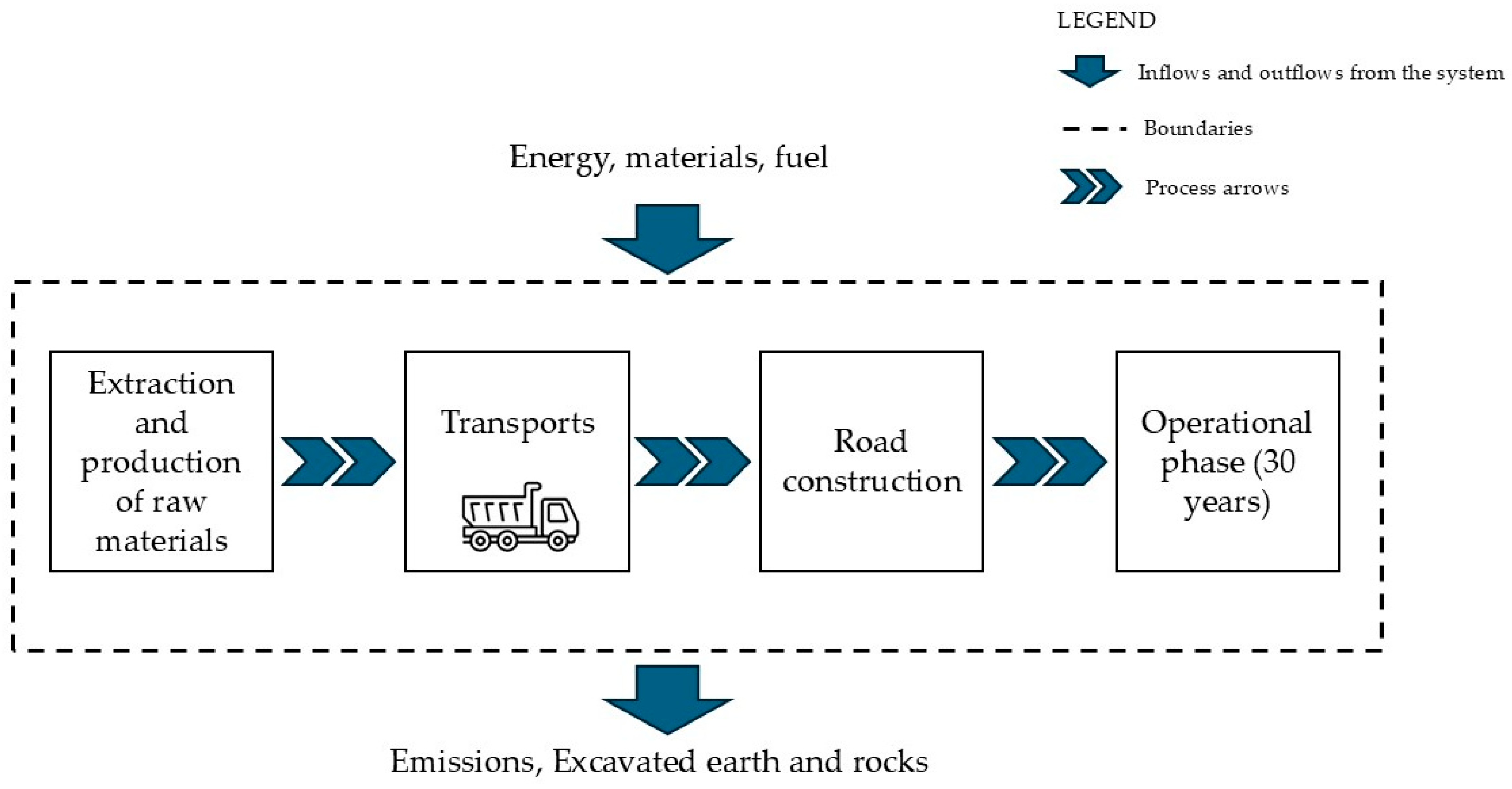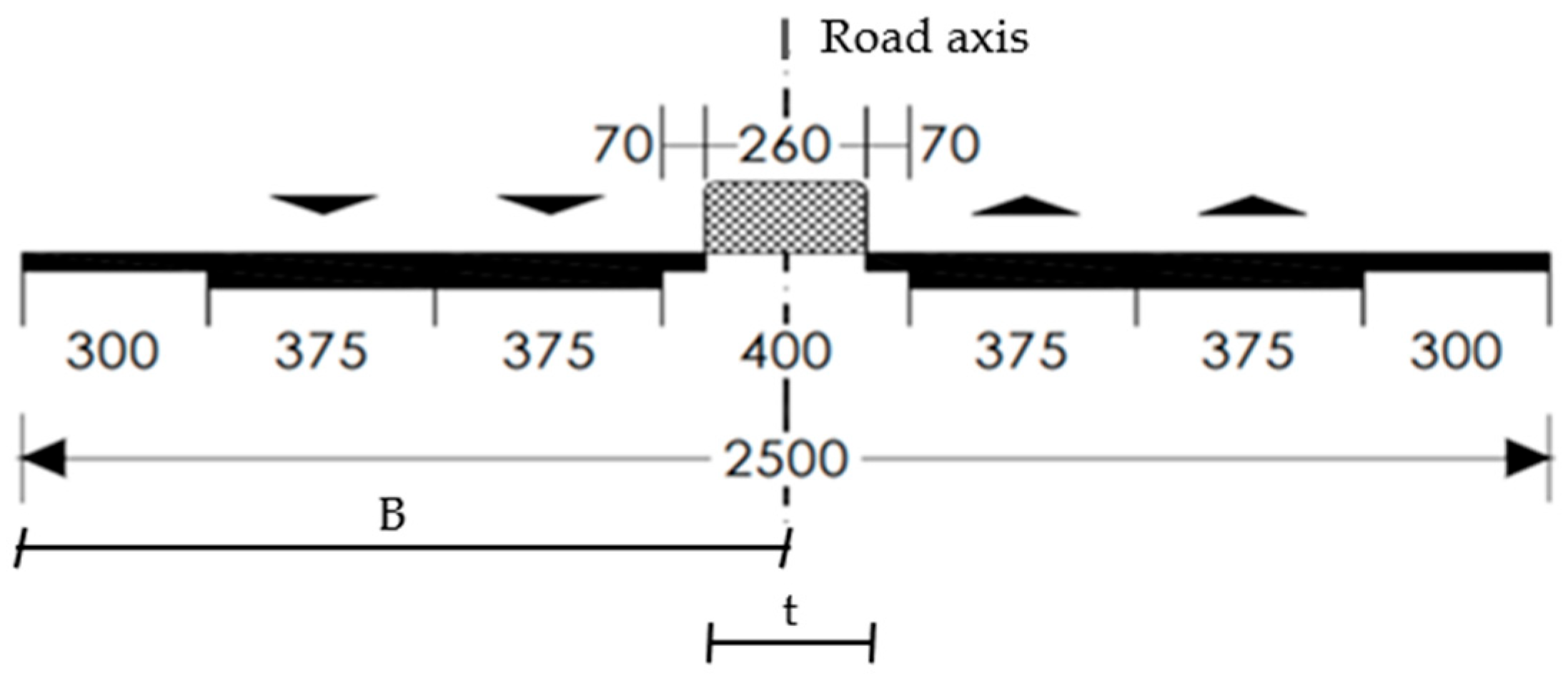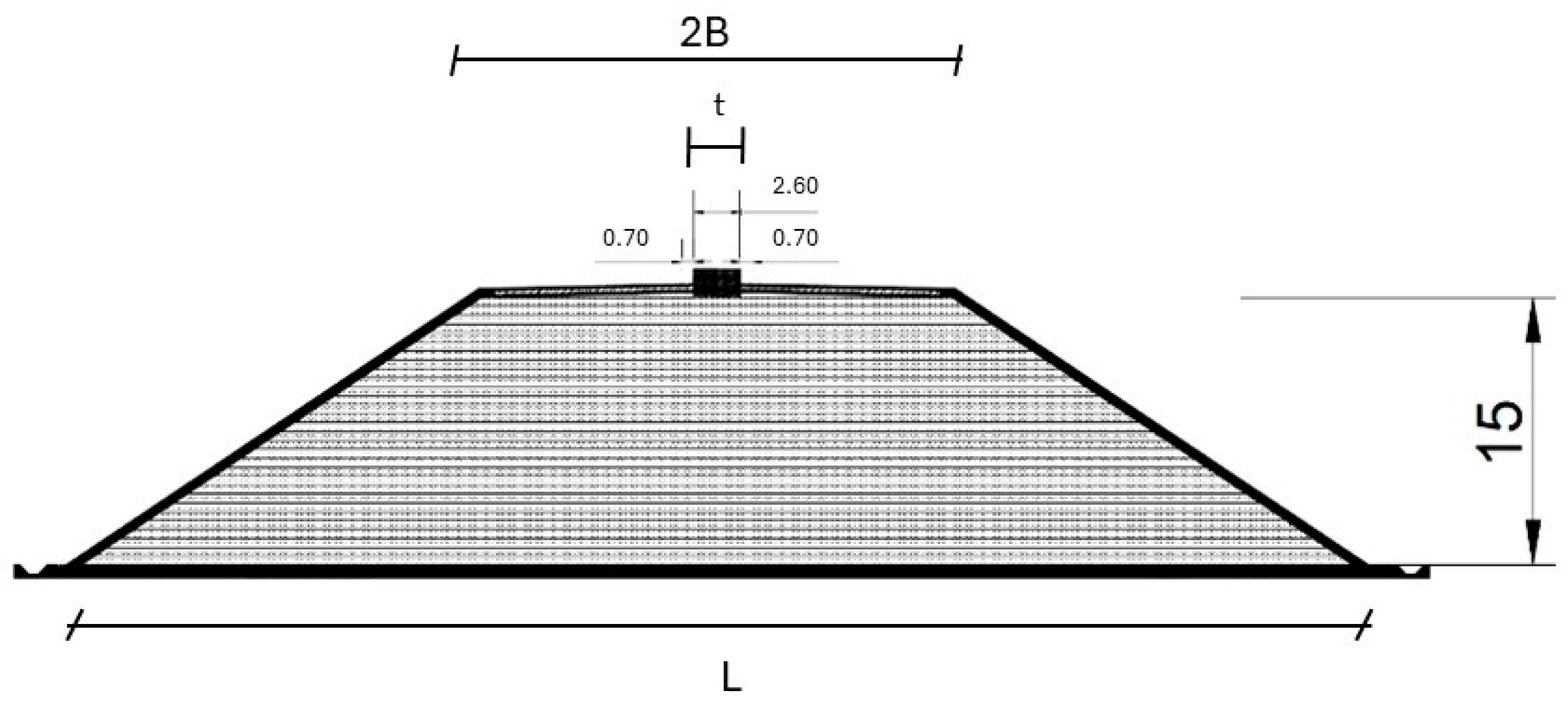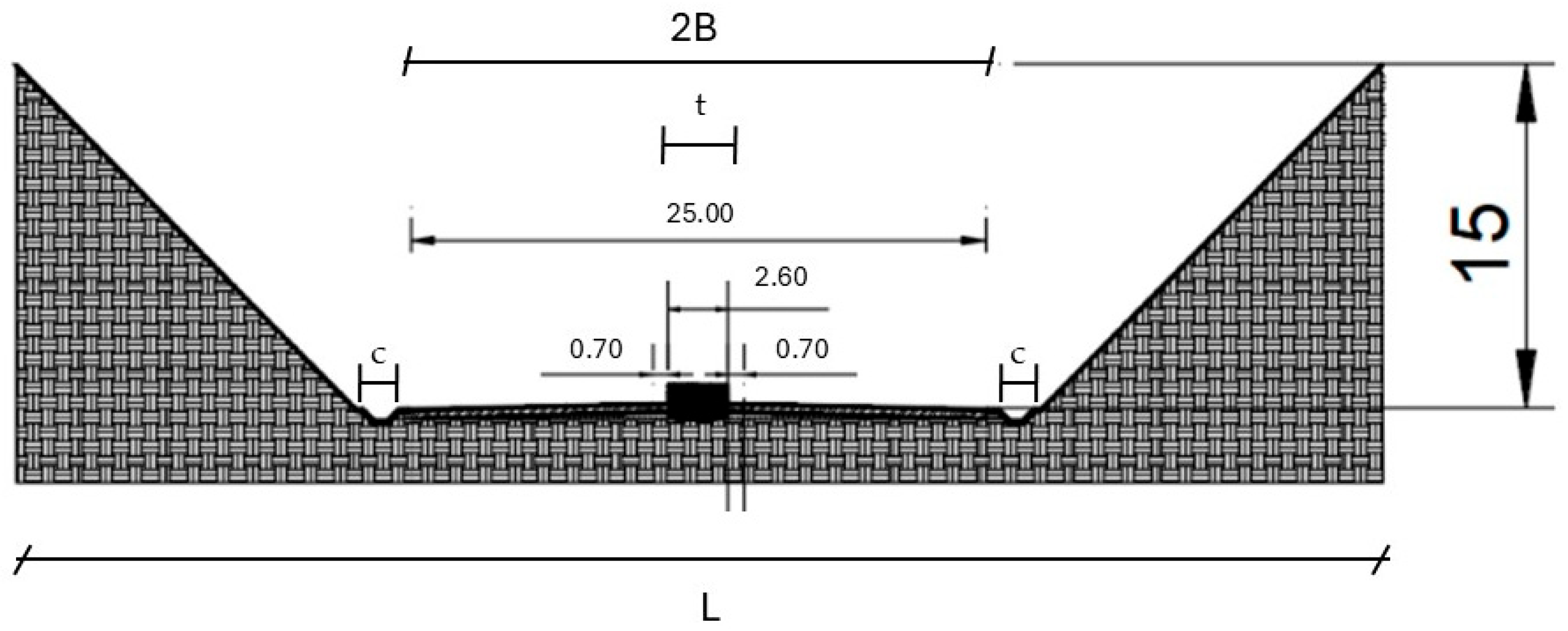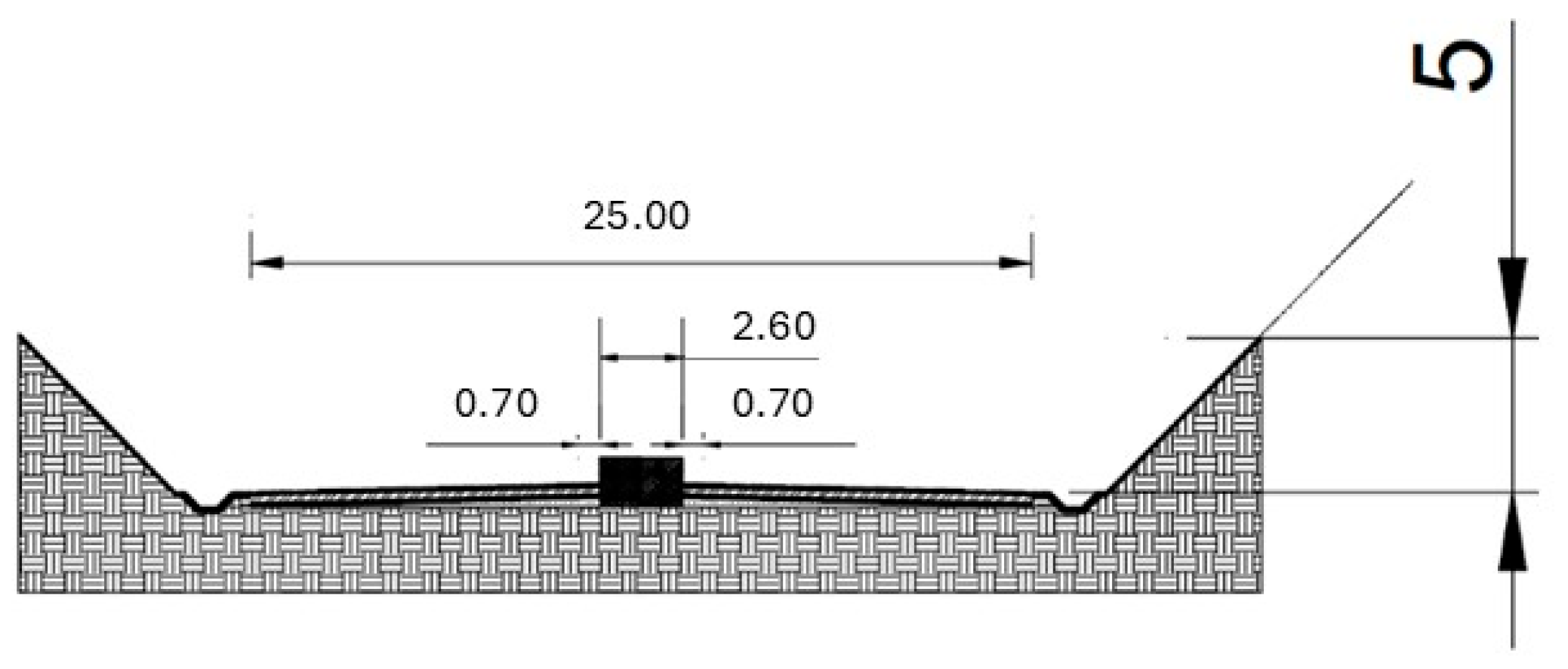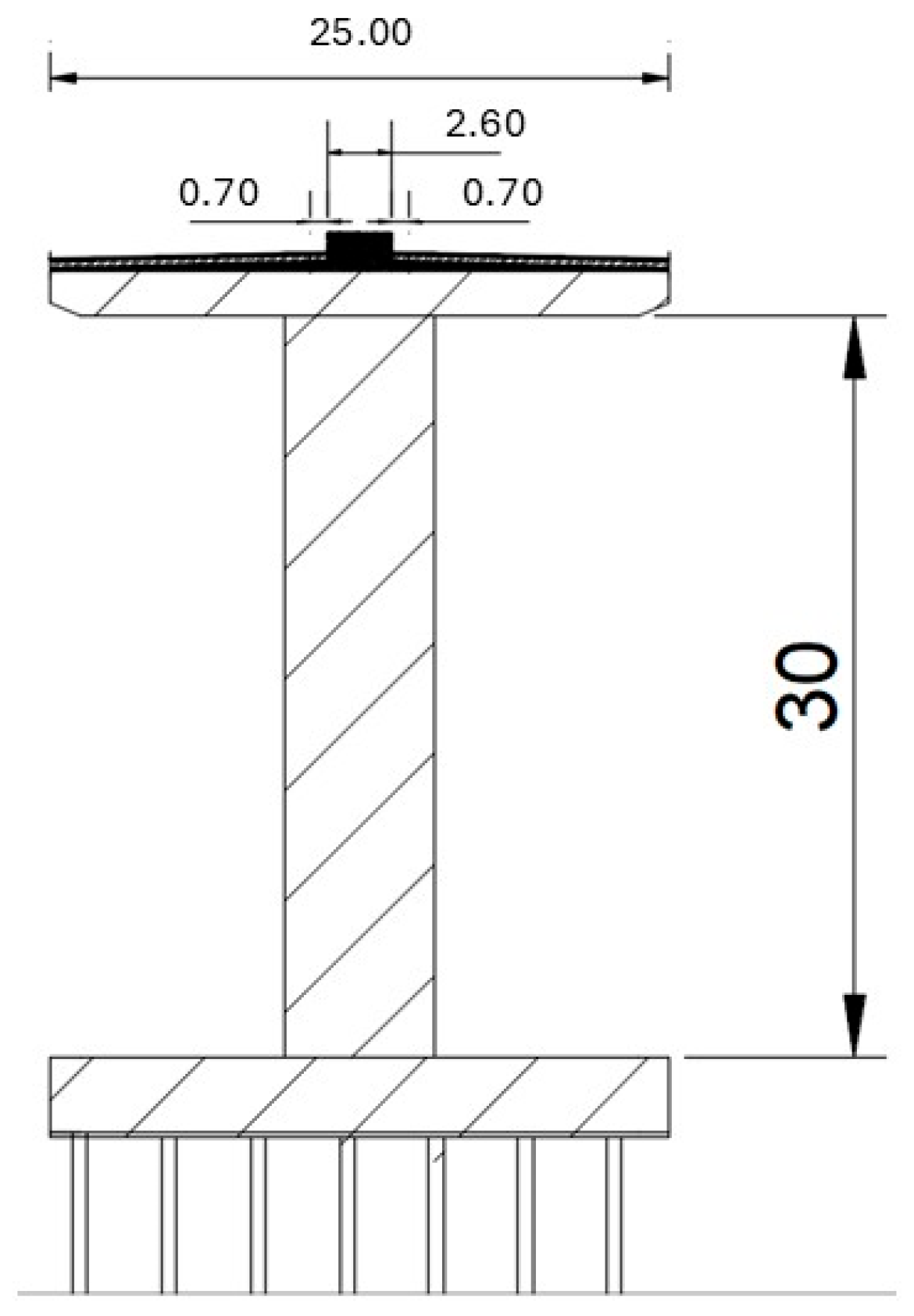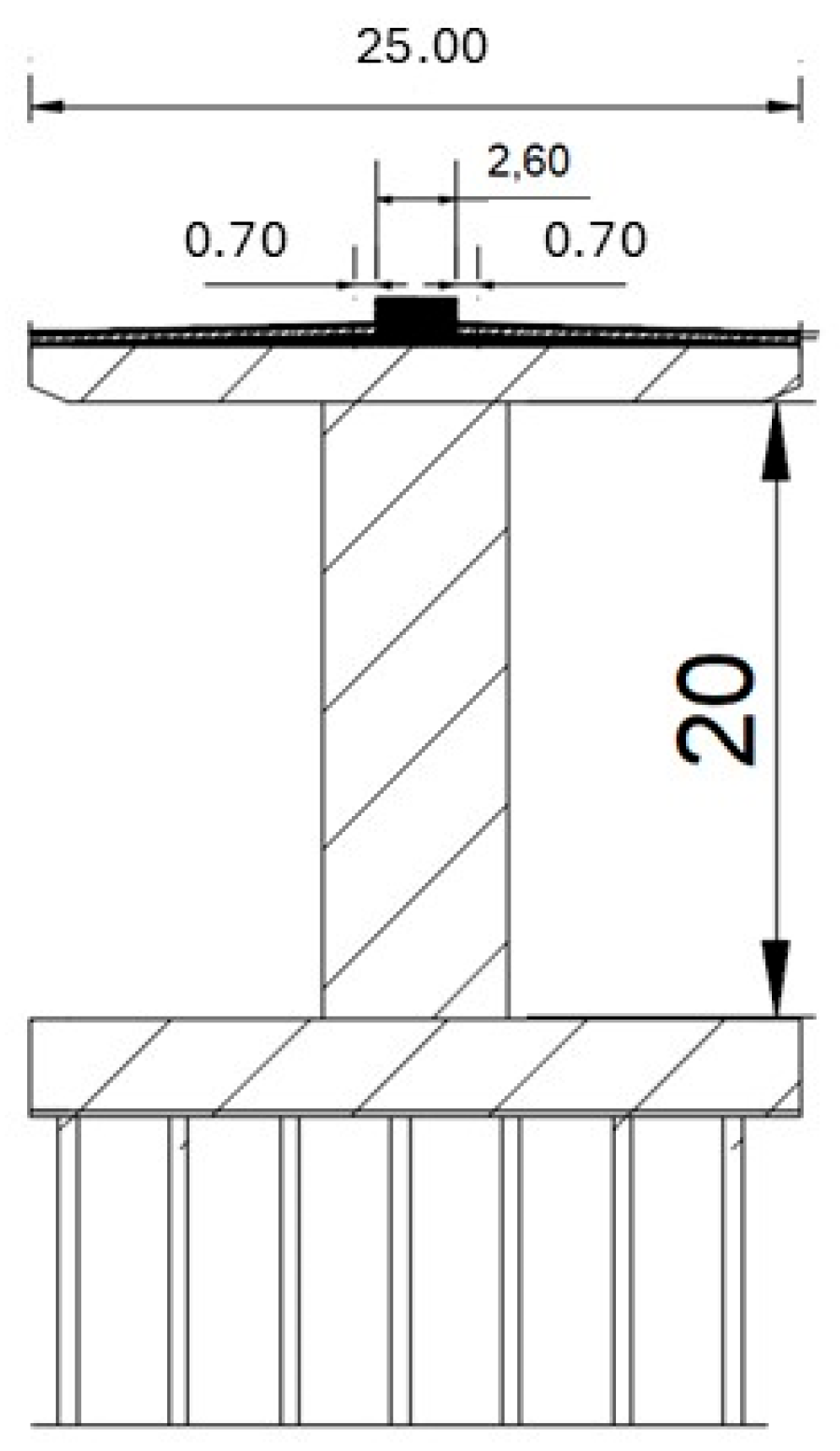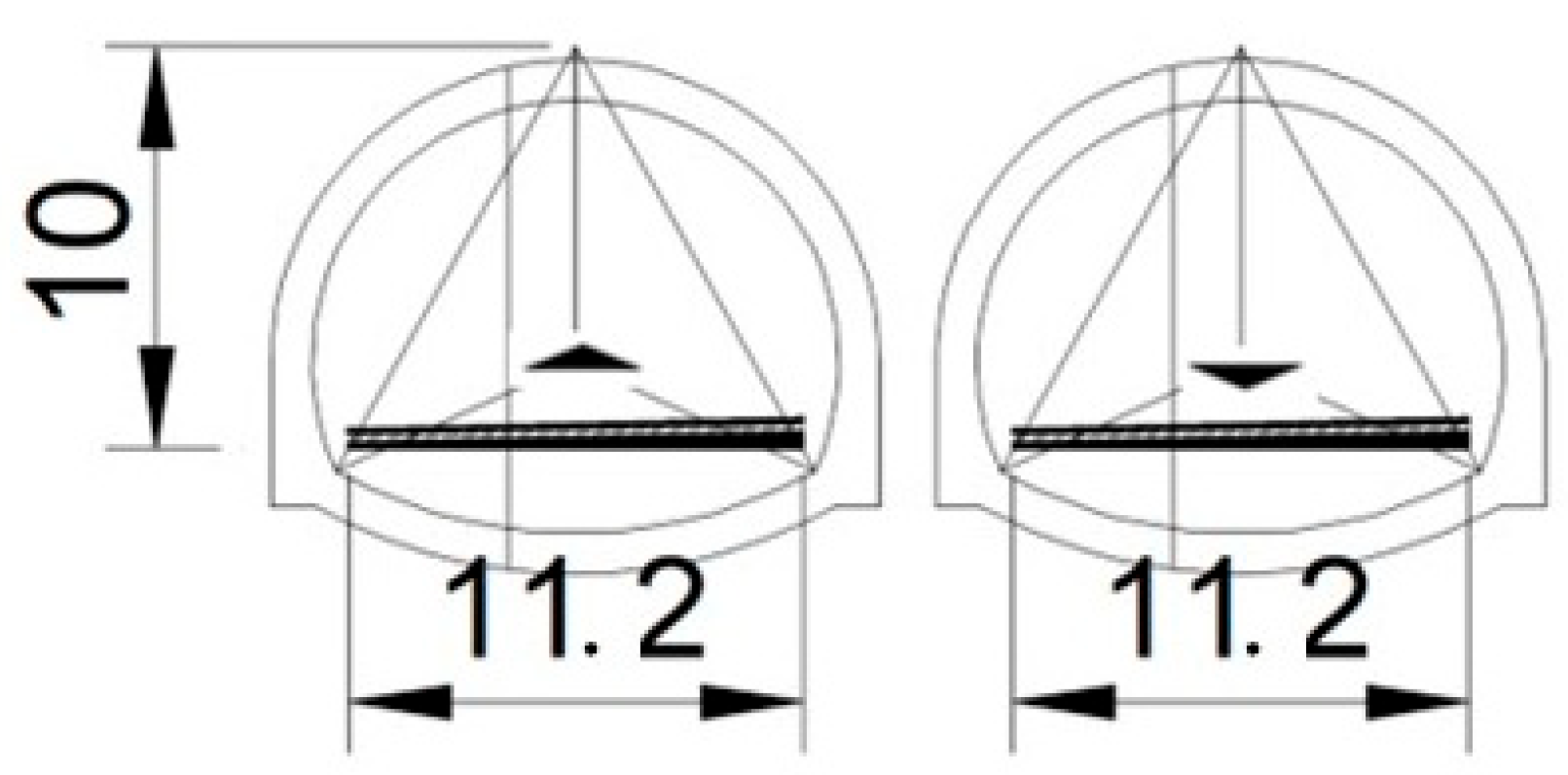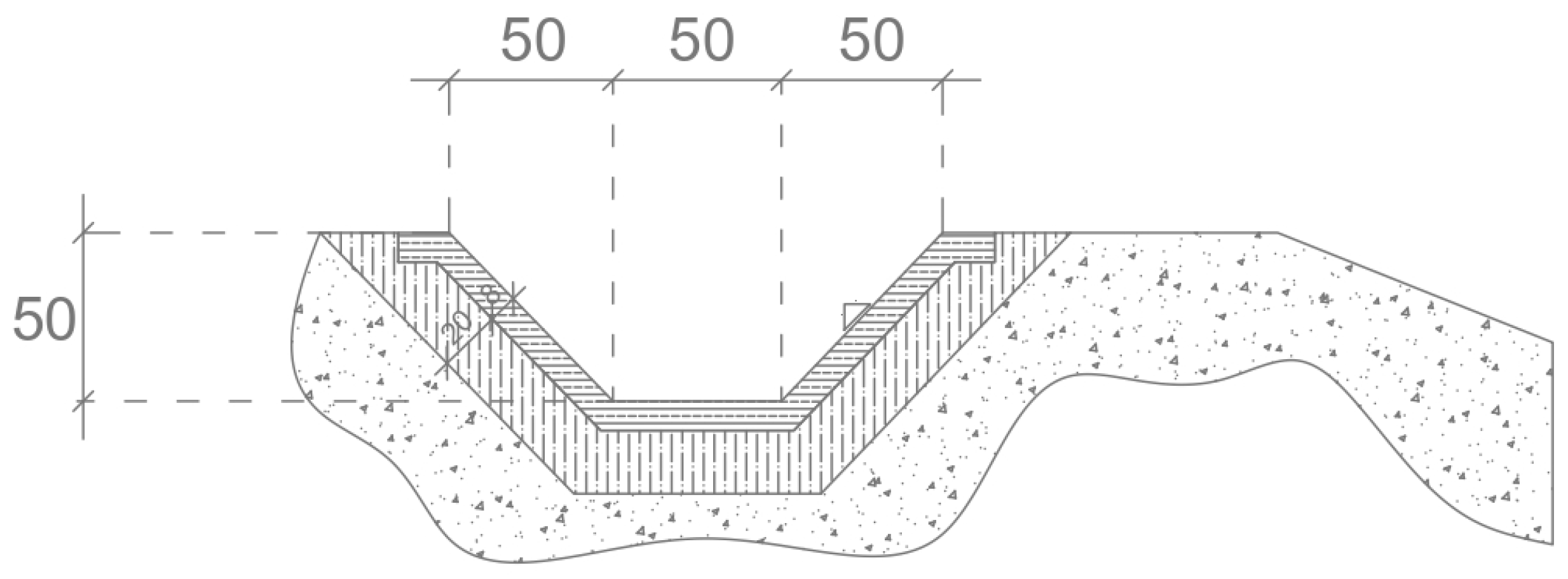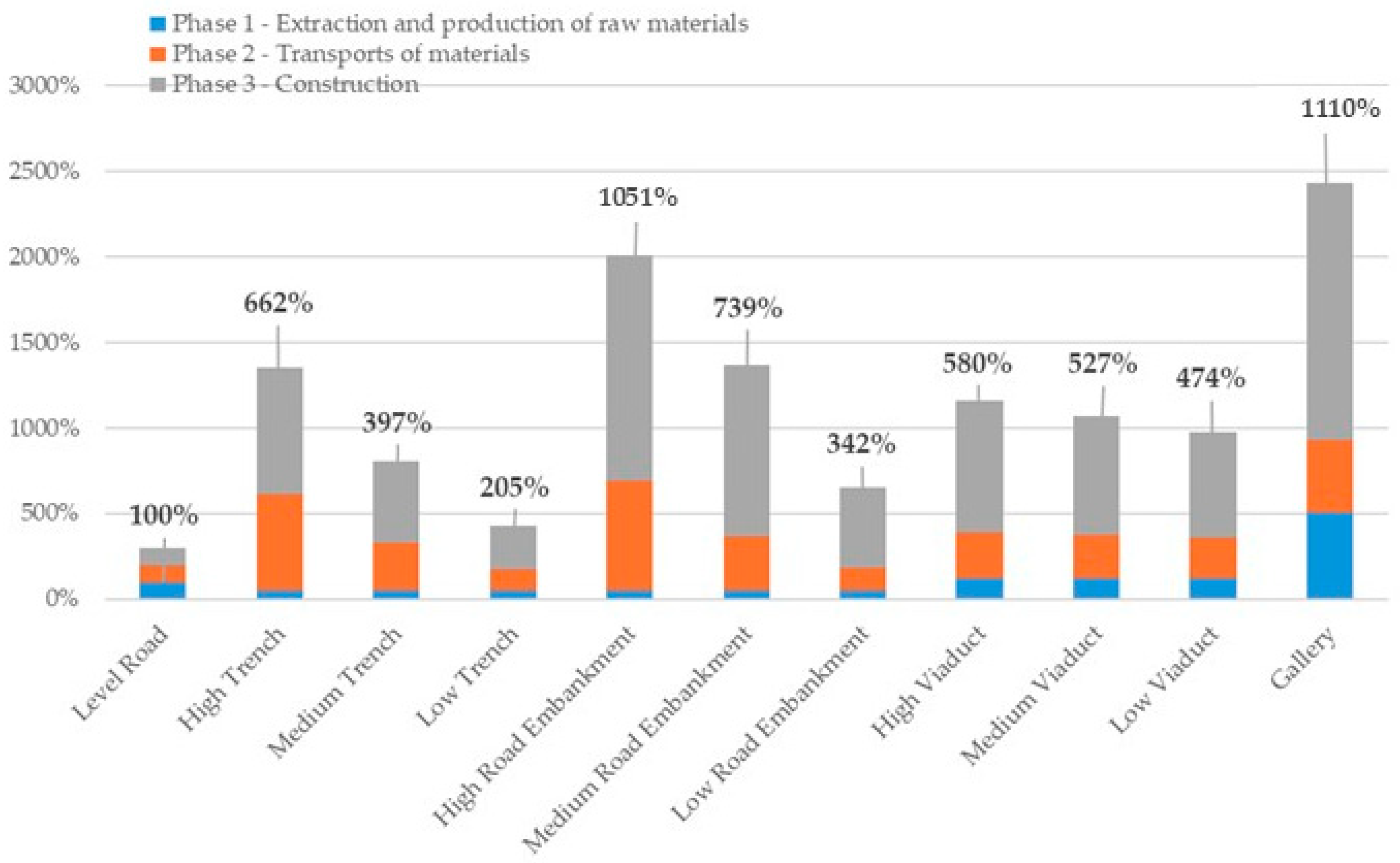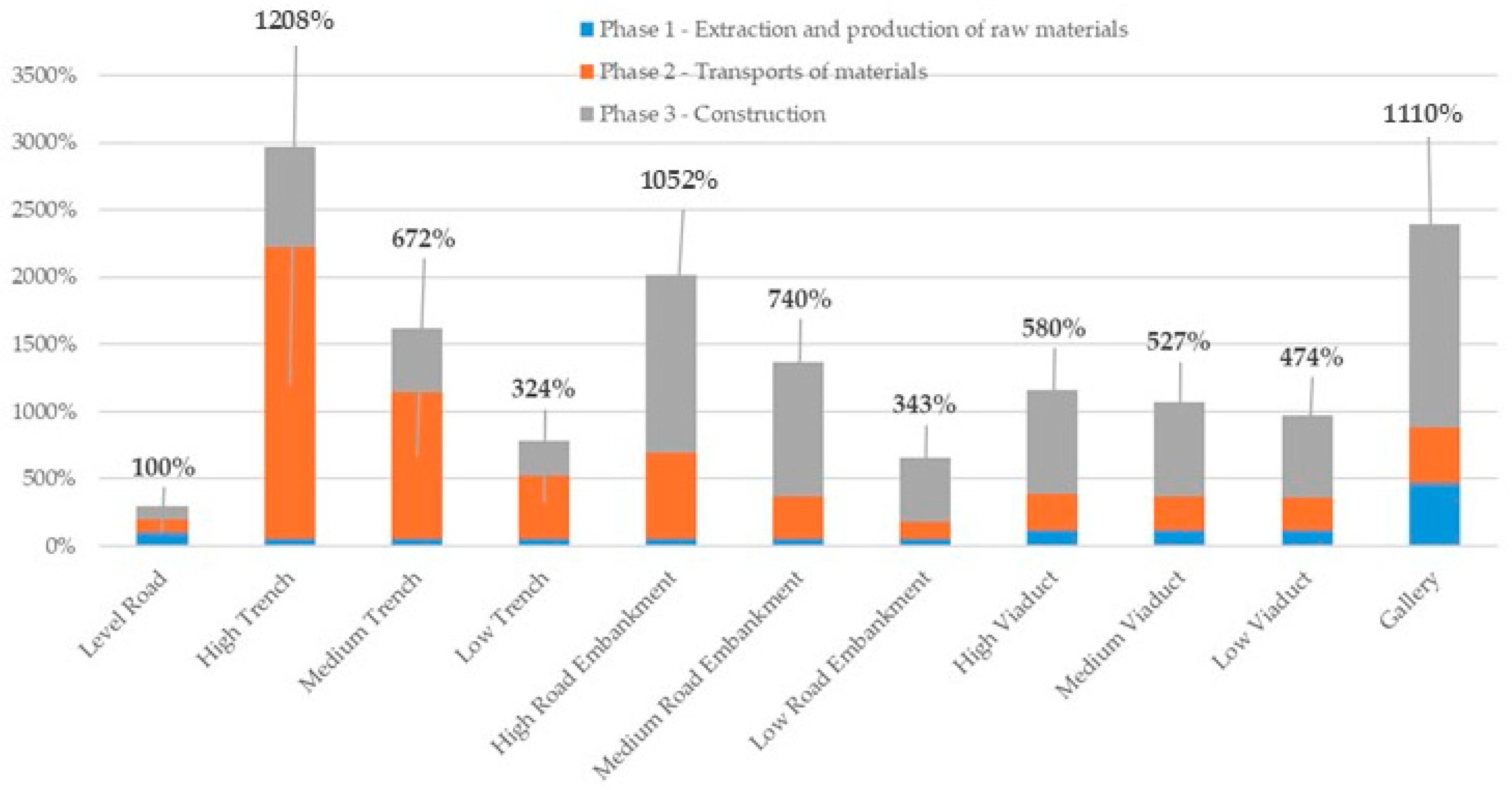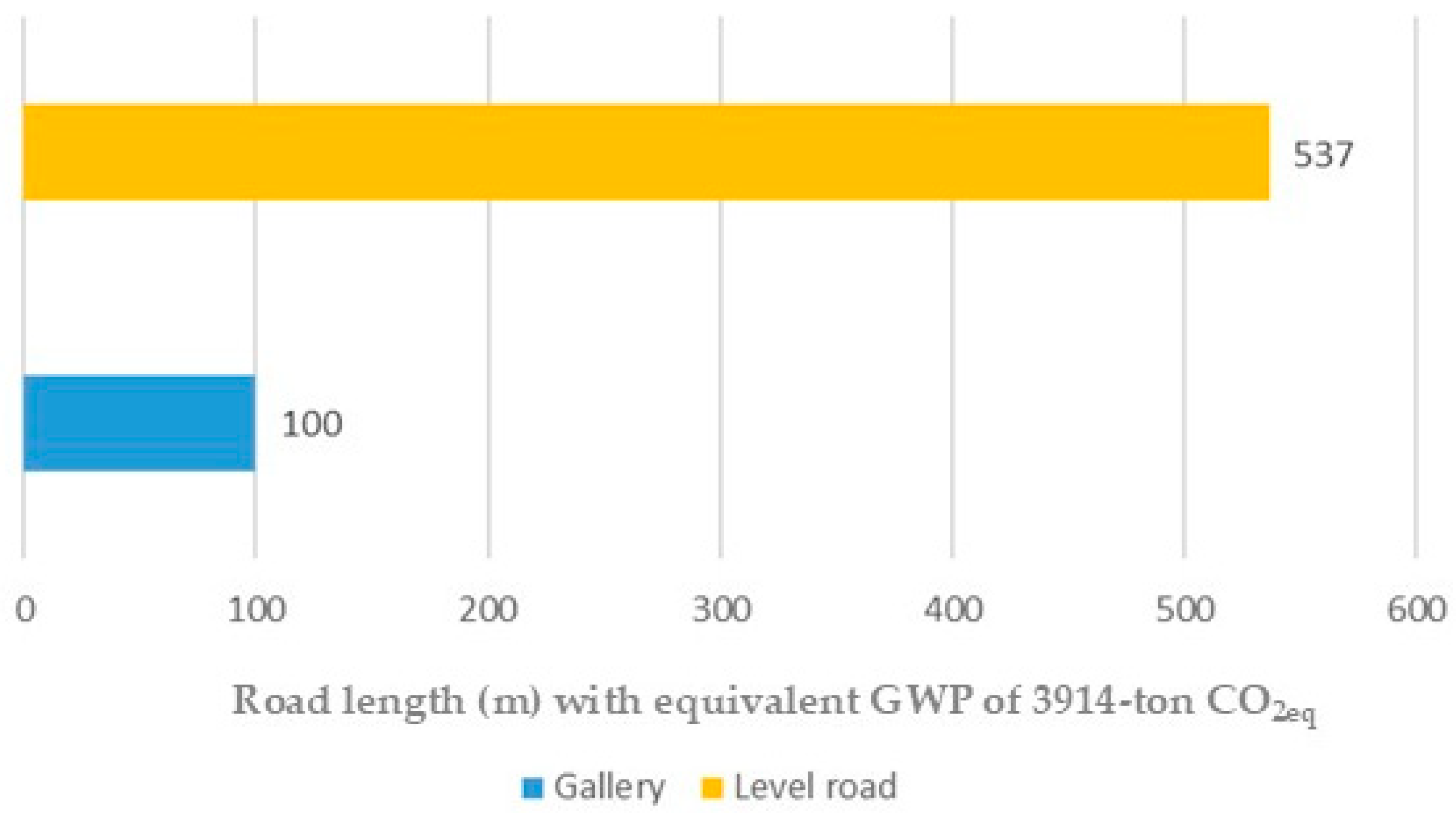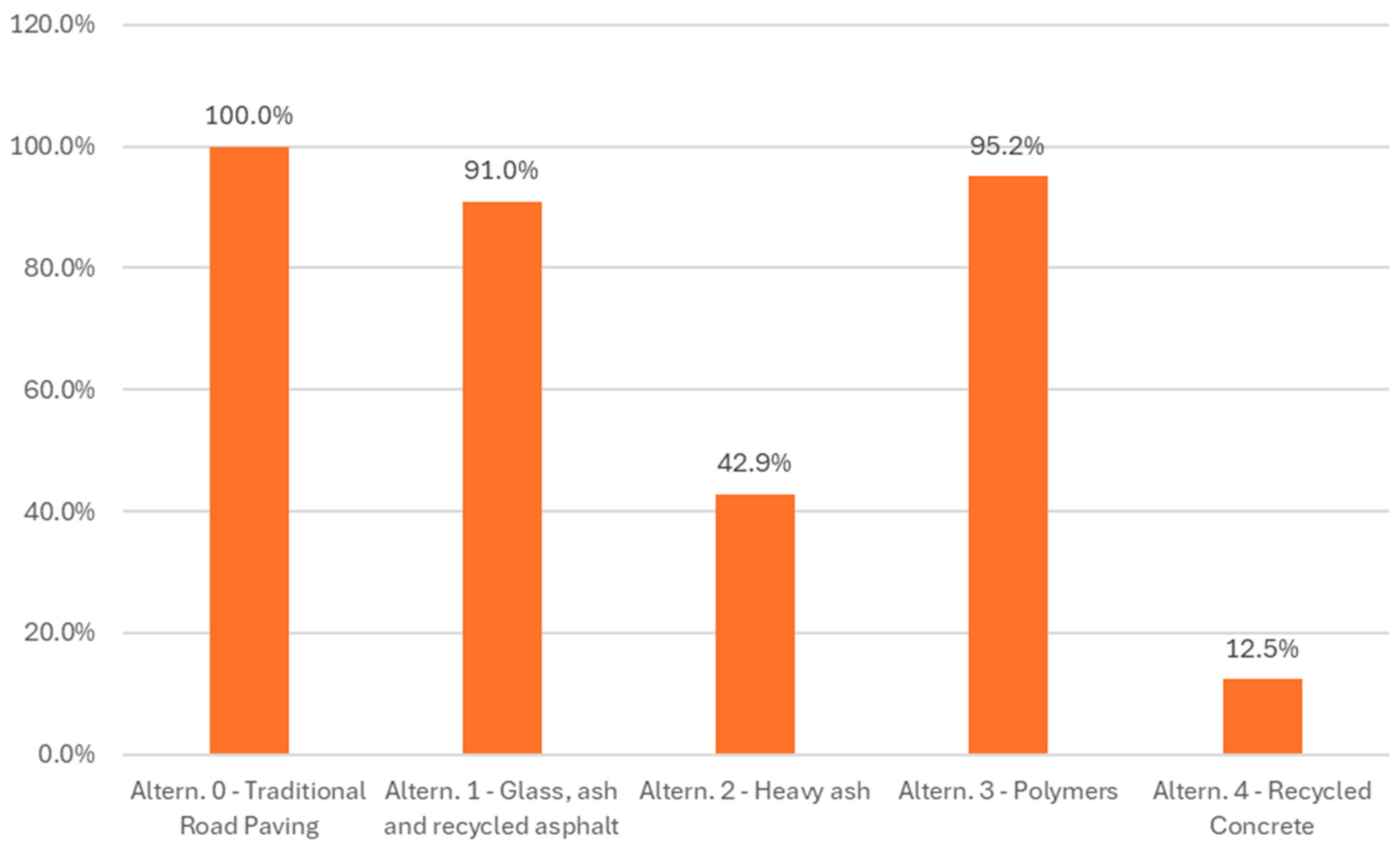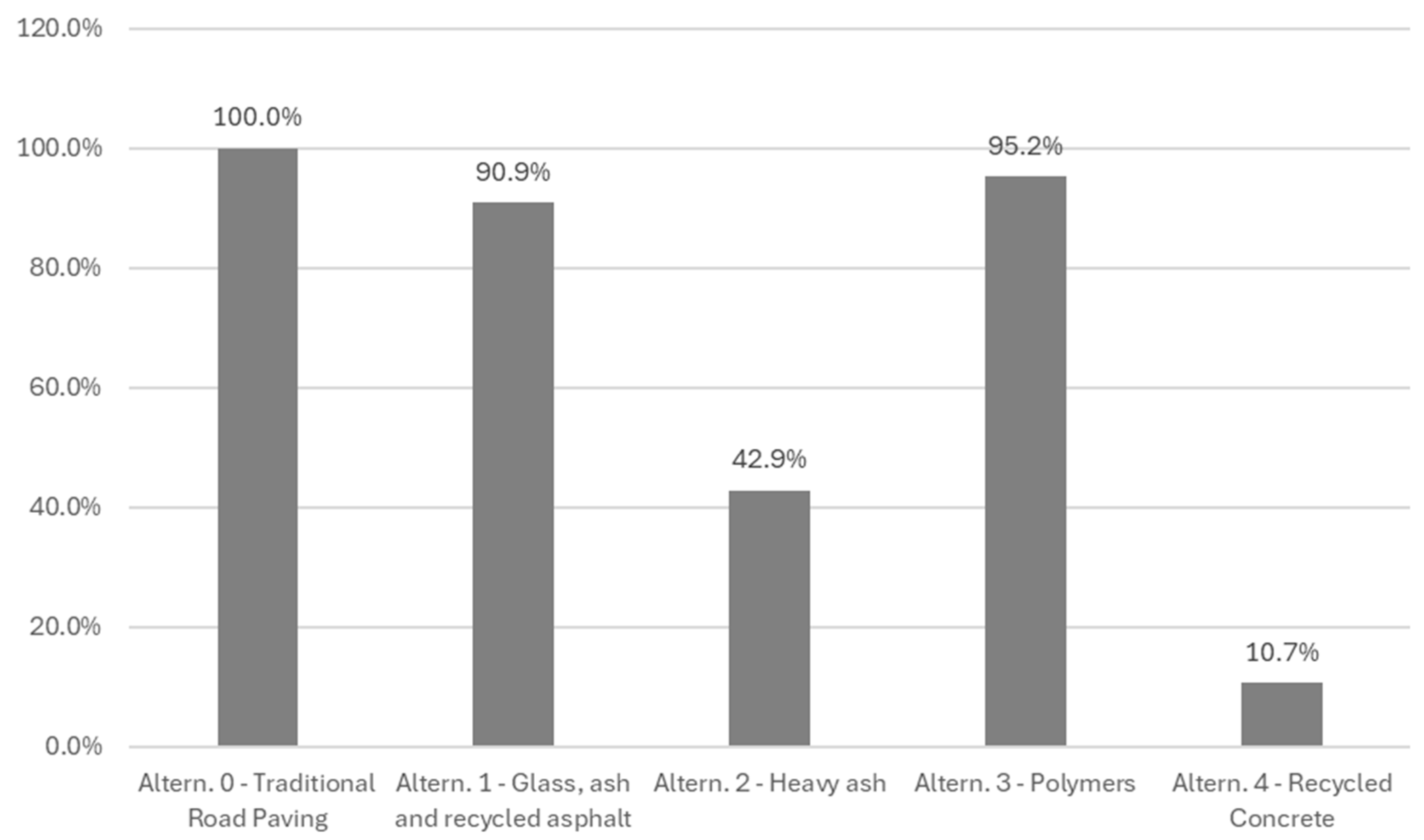Figure 1.
Boundaries of the system.
Figure 1.
Boundaries of the system.
Figure 2.
Category A Motorway—basic solution with 2 + 2 lanes (data in centimeters).
Figure 2.
Category A Motorway—basic solution with 2 + 2 lanes (data in centimeters).
Figure 3.
Road sub-layer thicknesses (cm) used in this study.
Figure 3.
Road sub-layer thicknesses (cm) used in this study.
Figure 4.
Modeled section of a high road embankment (m).
Figure 4.
Modeled section of a high road embankment (m).
Figure 5.
Modeled section of a medium road embankment (m).
Figure 5.
Modeled section of a medium road embankment (m).
Figure 6.
Modeled section of a low road embankment (m).
Figure 6.
Modeled section of a low road embankment (m).
Figure 7.
Modeled section of a high road trench (m).
Figure 7.
Modeled section of a high road trench (m).
Figure 8.
Modeled section of a medium road trench (m).
Figure 8.
Modeled section of a medium road trench (m).
Figure 9.
Modeled section of a low road trench (m).
Figure 9.
Modeled section of a low road trench (m).
Figure 10.
Section of a high viaduct (m).
Figure 10.
Section of a high viaduct (m).
Figure 11.
Section of a medium viaduct (m).
Figure 11.
Section of a medium viaduct (m).
Figure 12.
Section of a low viaduct (m).
Figure 12.
Section of a low viaduct (m).
Figure 13.
Modeled section of a natural tunnel in traditional excavation for the two directions—typical section of the intrados (m).
Figure 13.
Modeled section of a natural tunnel in traditional excavation for the two directions—typical section of the intrados (m).
Figure 14.
Guardrail section from technical data sheet (mm).
Figure 14.
Guardrail section from technical data sheet (mm).
Figure 15.
Section of a French-style curb, from technical data sheet (cm).
Figure 15.
Section of a French-style curb, from technical data sheet (cm).
Figure 16.
Percentage of electric cars in Italy 2017–2024 (the dotted line represents the interpolated data, while the solid line represents the actual data).
Figure 16.
Percentage of electric cars in Italy 2017–2024 (the dotted line represents the interpolated data, while the solid line represents the actual data).
Figure 17.
Forecasts for growth in the percentage of electric cars in Italy over 30 years (2017–2047) based on realistic data (2017–2024)—the data labels represent the number of electric vehicles present in that year.
Figure 17.
Forecasts for growth in the percentage of electric cars in Italy over 30 years (2017–2047) based on realistic data (2017–2024)—the data labels represent the number of electric vehicles present in that year.
Figure 18.
GWP [ton CO2eq—100 years] regarding Phases 1, 2, and 3 normalized to the at-grade road (100%).
Figure 18.
GWP [ton CO2eq—100 years] regarding Phases 1, 2, and 3 normalized to the at-grade road (100%).
Figure 19.
AP [kg SO2eq] regarding Phases 1, 2, and 3 normalized to the at-grade road (100%).
Figure 19.
AP [kg SO2eq] regarding Phases 1, 2, and 3 normalized to the at-grade road (100%).
Figure 20.
EP [kg PO4eq] regarding Phases 1, 2, and 3 normalized to the at-grade road (100%).
Figure 20.
EP [kg PO4eq] regarding Phases 1, 2, and 3 normalized to the at-grade road (100%).
Figure 21.
POCP [kg C2H4eq] regarding Phases 1, 2, and 3 normalized to the at-grade road (100%).
Figure 21.
POCP [kg C2H4eq] regarding Phases 1, 2, and 3 normalized to the at-grade road (100%).
Figure 22.
HTP (c, np) [kg 1,4-DBeq] regarding Phases 1, 2, and 3 normalized to the at-grade road (100%).
Figure 22.
HTP (c, np) [kg 1,4-DBeq] regarding Phases 1, 2, and 3 normalized to the at-grade road (100%).
Figure 23.
Comparison of tunnel length (100 m) and at-grade road length (537 m) with equivalent GWP of 3914 t CO2eq.
Figure 23.
Comparison of tunnel length (100 m) and at-grade road length (537 m) with equivalent GWP of 3914 t CO2eq.
Figure 24.
Comparison between CO2eq emissions of an at-grade road and a tunnel with and without an operational phase.
Figure 24.
Comparison between CO2eq emissions of an at-grade road and a tunnel with and without an operational phase.
Figure 25.
Comparison of carbon dioxide emissions (ton CO2/F.U.) for the construction of tunnels and viaducts (low, medium, high) using green concrete and green steel.
Figure 25.
Comparison of carbon dioxide emissions (ton CO2/F.U.) for the construction of tunnels and viaducts (low, medium, high) using green concrete and green steel.
Figure 26.
Comparison between % of CO2eq in the four alternatives scenarios and the case study (Alternative 0, equal to 100%).
Figure 26.
Comparison between % of CO2eq in the four alternatives scenarios and the case study (Alternative 0, equal to 100%).
Figure 27.
Comparison between % of SO2eq in the four alternatives scenarios and the case study (Alternative 0, equal to 100%).
Figure 27.
Comparison between % of SO2eq in the four alternatives scenarios and the case study (Alternative 0, equal to 100%).
Figure 28.
Comparison between % of PO4eq in the four alternatives scenarios and the case study (Alternative 0, equal to 100%).
Figure 28.
Comparison between % of PO4eq in the four alternatives scenarios and the case study (Alternative 0, equal to 100%).
Table 1.
Quantities of material (m3) required for 100 m of road with different types of cross-sections.
Table 1.
Quantities of material (m3) required for 100 m of road with different types of cross-sections.
| Material | Total Quantities (m3) |
|---|
| | Level Road | High Road Embankment (15 m) | Medium Road Embankment (10 m) | Low Road Embankment (5 m) | Road Trench | High Viaduct (30 m) | Medium Viaduct (20 m) | Low Viaduct (10 m) | Natural Gallery |
|---|
| Concrete | 76.6 | 76.6 | 76.6 | 76.6 | 76.6 | 1776.6 | 1476.6 | 1176.6 | 10,076.6 |
| Aggregates | 336.0 | 336.0 | 336.0 | 336.0 | 336.0 | 336.0 | 336.0 | 336.0 | 336.0 |
| Bituminous mixtures | 784.0 | 784.0 | 784.0 | 784.0 | 784.0 | 784.0 | 784.0 | 784.0 | 784.0 |
| Steel | 52.5 | 52.5 | 52.5 | 52.5 | 52.5 | 99.8 | 91.8 | 83.8 | 452.5 |
| Soil and rocks | - | 76,125.0 | 43,250.0 | 17,875.0 | - | - | - | - | - |
Table 2.
Quantity of materials (m3) to be delivered outside the construction site.
Table 2.
Quantity of materials (m3) to be delivered outside the construction site.
| Road Section | Total Quantities (m3) |
|---|
| Level road | 1000 |
| Raised | 1000 |
| Viaduct | 25,000 |
| High road trench (15 m) | 64,875 |
| Medium road trench (10 m) | 38,250 |
| Low road trench (5 m) | 16,625 |
| Tunnel | 23,000 |
Table 3.
Road superstructure data in relation to the road embankment.
Table 3.
Road superstructure data in relation to the road embankment.
| Physical Size | Symbol and Unit of Measurement | Bituminous Conglomerate | Granular Mixture |
|---|
| Thickness | s (m) | 0.35 | 0.15 |
| Useful road width | 2B-t (m) | 22.4 | 22.4 |
| Functional unit | f (m) | 100 | 100 |
| Road body layer | (m) | 0.5 | 0.5 |
| Volume (s × B × f) | V (m3) | 784.00 | 336.00 |
Table 4.
Road body data in relation to the road embankment.
Table 4.
Road body data in relation to the road embankment.
| Type | H (m) | L (m) | 2B (m) | C (m) | 2B + c (m) | A (m2) | V (m3) | N Layers |
|---|
| High | 15 | 75 | 25 | 1.5 | 26.5 | 761.3 | 76,125 | 30 |
| Medium | 10 | 60 | 25 | 1.5 | 26.5 | 432.5 | 43,250 | 20 |
| Low | 5 | 45 | 25 | 1.5 | 26.5 | 178.8 | 17,875 | 10 |
Table 5.
Road superstructure data in relation to the road trench.
Table 5.
Road superstructure data in relation to the road trench.
| Physical Size | Symbol and Unit of Measurement | Bituminous Conglomerate | Granular Mixture |
|---|
| Thickness of the road package | s (m) | 0.35 | 0.15 |
| Useful road width | 2B-t (m) | 22.4 | 22.4 |
| Functional unit | f (m) | 100 | 100 |
| Road body layer | (m) | 0.5 | 0.5 |
| Volume (s × B × f) | V (m3) | 784.00 | 336.00 |
Table 6.
Data relating to the excavation of the road trench.
Table 6.
Data relating to the excavation of the road trench.
| Type | h(m) | L(m) | 2B(m) | A(m2) | V(m3) |
|---|
| High | 15 | 60 | 26.5 | 648.8 | 64,875 |
| Medium | 10 | 50 | 26.5 | 382.5 | 38,250 |
| Low | 5 | 40 | 26.5 | 166.3 | 16,625 |
Table 7.
Road superstructure data in relation to the viaduct.
Table 7.
Road superstructure data in relation to the viaduct.
| Physical Size | Symbol and Unit of Measurement | Bituminous Conglomerate | Granular Mixture |
|---|
| Thickness | s (m) | 0.35 | 0.15 |
| Road width | (m) | 25.0 |
| Useful road width | 2B-t (m) | 22.4 | 22.4 |
| Functional unit | f (m) | 100 | 100 |
| Road body layer | (m) | 0.5 | 0.5 |
| Volume (s × B × f) | V (m3) | 784.0 | 336.0 |
| Viaduct pile thickness | (m) | 1.00 | |
Table 8.
Data relating to the type of the viaduct.
Table 8.
Data relating to the type of the viaduct.
| Type | High | Medium | Low |
|---|
| Concrete (m2) | 220 | 280 | 340 |
| Centre distance between pillars (m) | 20 |
| Number of pillars for F.U. | 65 |
| Excavation depth (m) | 10 |
| Percentage of steel relative to concrete (%) | 2.7 |
Table 9.
Road superstructure data in relation to the tunnel.
Table 9.
Road superstructure data in relation to the tunnel.
| Physical Size | Symbol and Unit of Measurement | Bituminous Conglomerate | Granular Mixture |
|---|
| Thickness | s (m) | 0.35 | 0.15 |
| Useful road width | 2B-t (m) | 22.4 | 22.4 |
| Functional unit | f (m) | 100 | 100 |
| Road body layer | (m) | 0.5 | 0.5 |
| Volume (s × B × f) | V (m3) | 784.0 | 336.0 |
Table 10.
Data relating to the tunnel.
Table 10.
Data relating to the tunnel.
| Physical Size | Values |
|---|
| Excavation for single tunnel (m2) | 110 |
| Excavation for single tunnel (m3) | 11,000 |
| Topsoil stripping (m) | 1000 |
| Topsoil stripping depth (m) | 0.4 |
| Number of tunnels | 2 |
Table 11.
Quantity of materials required to produce the road package per functional unit.
Table 11.
Quantity of materials required to produce the road package per functional unit.
| Materials | Quantities |
|---|
| Bituminous conglomerate (m3) | 784 |
| Aggregates (m3) | 336 |
| Steel (ton) | 393 |
| Concrete (ton) | 176 |
Table 12.
Composition of materials.
Table 12.
Composition of materials.
| Materials | Bituminous Conglomerate | Granular Mixture |
|---|
| | % | m3 | % | m3 |
| Bitumen | 4 | 31,360 | 20 | 67,200 |
| Filler | 19.2 | 150,528 | 20 | 67,200 |
| Crushed stone | 19.2 | 150,528 | 20 | 67,200 |
| Sand | 19.2 | 150,528 | 20 | 67,200 |
| Grit | 19.2 | 150,528 | 20 | 67,200 |
| Crushed stone | 19.2 | 150,528 | 20 | 67,200 |
| Total | 100 | 784,000 | 100 | 336,000 |
Table 13.
Hours of excavator operation required to extract the raw materials for each road section.
Table 13.
Hours of excavator operation required to extract the raw materials for each road section.
| Road Section | Hour (h) |
|---|
| Flat surface, road embankment, and road trench | 14 |
| High viaduct | 33 |
| Medium viaduct | 30 |
| Low viaduct | 26 |
| Tunnel | 129 |
Table 14.
Emission indicators for the production of raw materials from various databases.
Table 14.
Emission indicators for the production of raw materials from various databases.
| Road Section | Palate | Ecorce M | Aspect |
|---|
| Aggregate emission factor [kg CO2eq/ton] | 2.47 | 2.19 | 2.70 |
| Bitumen emission factor [kg CO2eq/ton] | 183.96 | 191.38 | 202.70 |
| Bituminous conglomerate emission factor [kg CO2eq/ton] | 16.80 | 23.97 | 19.56 |
Table 15.
Assumption for defining emissions relating to the transport phase of materials.
Table 15.
Assumption for defining emissions relating to the transport phase of materials.
| General Assumption | Value |
|---|
| Truck power (hp) | 250 1 |
| Average truck speed (km/h) | 50 3 |
| Truck capacity (m3) | 17 1 |
| Type of street | Two-way |
| Distance from the raw material production site (km) | 50 2 |
| Distance of construction sites for earth and rocks (km) | 5 2 |
| Power supply | Diesel fuel 1 |
| Diesel fuel density (kg/L) | 0.835 |
Table 16.
Average Daily Traffic (ADT) on Italian motorways published by ANAS S.p.A. for the year 2023.
Table 16.
Average Daily Traffic (ADT) on Italian motorways published by ANAS S.p.A. for the year 2023.
| ADT |
|---|
| Light-Vehicle | Heavy-Vehicle | Total |
|---|
| 12,000 | 550 | 12,550 |
Table 17.
Emission indicators to produce raw materials from various databases.
Table 17.
Emission indicators to produce raw materials from various databases.
| Emission Factor [g/km × Vehicle] |
|---|
| Pollutant | Light-Vehicle | Heavy-Vehicle |
|---|
| CO | 0.62 | 0.89 |
| NOX | 0.36 | 0.73 |
| SOX | 0.001 | 0.03 |
| PM10 | 0.01 | 0.14 |
| CO2 | 167.76 | 558.35 |
| CH4 | 0.003 | 0.03 |
Table 18.
Impact values of the different environmental categories chosen for the operational phase (Phase 4) considering an annual percentage increase of 1% in ADT.
Table 18.
Impact values of the different environmental categories chosen for the operational phase (Phase 4) considering an annual percentage increase of 1% in ADT.
| GWP [Ton CO2eq] | AP [kg SO2eq] | EP [kg PO4eq] | POCP [kg C2H4eq] | HTP (c, np) [kg 1.4-DBeq] |
|---|
| 3102.1 | 3000.5 | 771.0 | 436.3 | 31,296.1 |
Table 19.
GWP for different road sections.
Table 19.
GWP for different road sections.
| Global Warming Potential (Ton CO2eq) |
|---|
| Phase | Level Road
Ton CO2eq | Road Trench (High)
Ton CO2eq | Road Trench (Medium)
Ton CO2eq | Road Trench (Low)
Ton CO2eq | Road Embankment (High)
Ton CO2eq | Road Embankment (Medium)
Ton CO2eq | Road Embankment (Low)
Ton CO2eq | Viaduct (High)
Ton CO2eq | Viaduct (Medium)
Ton CO2eq | Viaduct (Low)
Ton CO2eq | Gallery
Ton CO2eq |
|---|
| Extraction and production of materials | 699.0 | 699.0 | 699.0 | 699.0 | 699.0 | 699.0 | 699.0 | 1779.2 | 1586.7 | 1400.5 | 3604.9 |
| Transport of materials | 12.1 | 67.7 | 34.0 | 14.8 | 77.7 | 38.5 | 15.9 | 49.0 | 46.3 | 43.6 | 77.1 |
| Construction | 18.0 | 122.4 | 78.7 | 43.2 | 199.4 | 120.8 | 60.1 | 142.7 | 128.6 | 114.5 | 232.0 |
| Operational phase (30 year) | 2676.7 |
Table 20.
Comparison of pollutants emissions between Alternative 0 and Alternative 1.
Table 20.
Comparison of pollutants emissions between Alternative 0 and Alternative 1.
| Pollutants (ton) | Alternative 0 | Alternative 1 |
|---|
| CO2 | 888 | 869 |
| SO2 | 2370 | 2230 |
| NOX | 4740 | 4310 |
Table 21.
Comparison between the impact categories of Alternative 0 and Alternative 1.
Table 21.
Comparison between the impact categories of Alternative 0 and Alternative 1.
| Environmental Categories | Alternative 0 | Alternative 1 |
|---|
| GWP [ton CO2eq—100 years] | 699.0 | 684.0 |
| AP [ton SO2eq] | 1436 | 1307 |
| EP [ton PO4eq] | 0.369 | 0.336 |
Table 22.
Comparison of pollutants emissions between Alternative 0 and Alternative 2.
Table 22.
Comparison of pollutants emissions between Alternative 0 and Alternative 2.
| Pollutants (Ton) | Alternative 0 | Alternative 2 |
|---|
| CO2 | 41 | 18 |
| SO2 | 0.02 | 0.009 |
| NOX | 0.35 | 0.15 |
Table 23.
Comparison between the impact categories of Alternative 0 and Alternative 2.
Table 23.
Comparison between the impact categories of Alternative 0 and Alternative 2.
| Environmental Categories | Alternative 0 | Alternative 2 |
|---|
| GWP [ton CO2eq—100 years] | 699.0 | 306.9 |
| AP [ton SO2eq] | 1436 | 0.616 |
| EP [ton PO4eq] | 0.369 | 0.158 |
Table 24.
Comparison of pollutants emissions between Alternative 0 and Alternative 3.
Table 24.
Comparison of pollutants emissions between Alternative 0 and Alternative 3.
| Pollutants (Ton) | Alternative 0 | Alternative 3 |
|---|
| CO2 | 121.64 | 116.44 |
| SO2 | 0.22 | 0.21 |
| NOX | 0.62 | 0.59 |
Table 25.
Comparison between the impact categories of Alternative 0 and Alternative 3.
Table 25.
Comparison between the impact categories of Alternative 0 and Alternative 3.
| Environmental Categories | Alternative 0 | Alternative 3 |
|---|
| GWP [ton CO2eq—100 years] | 699.0 | 669.1 |
| AP [ton SO2eq] | 1436 | 1.367 |
| EP [ton PO4eq] | 0.369 | 0.351 |
Table 26.
Comparison of pollutants emissions between Alternative 0 and Alternative 4.
Table 26.
Comparison of pollutants emissions between Alternative 0 and Alternative 4.
| Pollutants (Ton) | Alternative 0 | Alternative 4 |
|---|
| CO2 | 8487 | 20,315 |
| SO2 | 0.029 | 0.05 |
| NOX | 0.457 | 0.049 |
Table 27.
Comparison between the impact categories of Alternative 0 and Alternative 4.
Table 27.
Comparison between the impact categories of Alternative 0 and Alternative 4.
| Environmental Categories | Alternative 0 | Alternative 4 |
|---|
| GWP [ton CO2eq—100 years] | 699.0 | 1673.1 |
| AP [ton SO2eq] | 1436 | 0.180 |
| EP [ton PO4eq] | 0.369 | 0.040 |
Table 28.
Comparison between advantages, limitations, and challenges of alternative materials used.
Table 28.
Comparison between advantages, limitations, and challenges of alternative materials used.
| Materials | Advantages | Limitation | Challenge |
|---|
| Ashes from the incineration of municipal solid waste (MSW) | Reduction in environmental damage caused by landfill disposal. | Since incineration is not a technique used in all countries, the availability of material for constructing roads of sufficient length and width could be compromised. | Develop a method for deactivating the heavy metals contained in this type of ash before it is used in road construction so that it does not generate leachate that can reach the soil and groundwater. |
| Scrap glass | Reduction in environmental damage resulting from recycling for the development of new glass.
Use of traditional materials. | Waste glass used as aggregate in construction consumes more energy and releases more CO2 overall than disposal in landfills. | Identify other environmental benefits that exceed the limits of the system in quarry analyses, transport scenarios, landfill restrictions, etc.
Particular attention should be paid to the porosity of slag, as it can lead to an increase in asphalt consumption. |
| Polymers | The use of recycled materials in asphalt layers reduces gas emissions during the construction phase, thanks to the reduced use of raw materials. | Costs and resources required for its transformation into material suitable for mixing with asphalt. | Although other variables may be included in the LCA, for this material it is necessary to include the economic and social effects of using recycled material. |
| Recycled concrete | Energy consumption, GWP, and costs are inversely proportional to the recycled asphalt content. Therefore, a significant advantage is obtained with a high recycled asphalt content. | The material combined with asphalt cracks during the winter season. | - |
Table 29.
Comparison of results in different environmental impact categories based on ADT equal to the case study value, double that value, and half that value.
Table 29.
Comparison of results in different environmental impact categories based on ADT equal to the case study value, double that value, and half that value.
| Environmental Categories | ADT 12,550 | ADT 6275 | ADT 25,100 |
|---|
| GWP [ton CO2eq—100 years] | 3102.1 | 1338.4 | 5353.5 |
| AP [kg SO2eq] | 3000.5 | 1294.6 | 5178.2 |
| EP [kg PO4eq] | 771.0 | 332.6 | 1330.6 |
| POCP [kg C2H4eq] | 436.3 | 188.2 | 753.0 |
| HTP(c, np) [kg 1.4-DBeq] | 31,296.1 | 13,502.5 | 54,010.0 |
